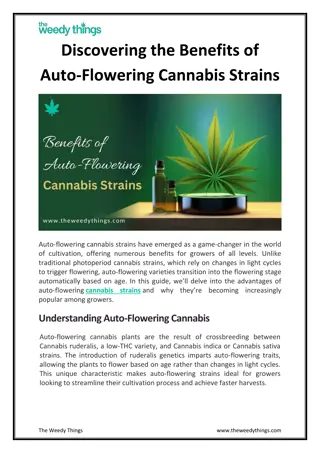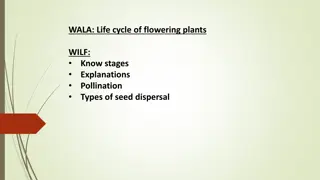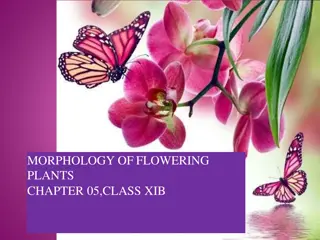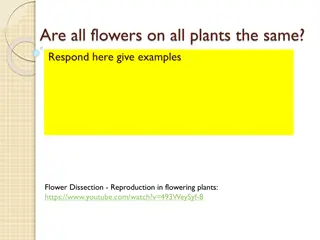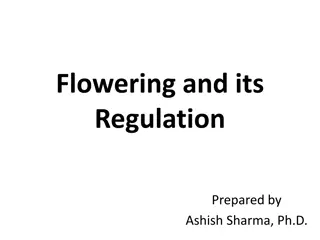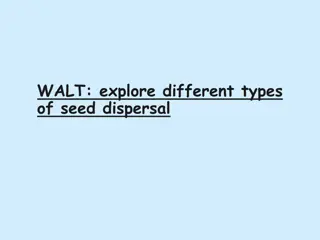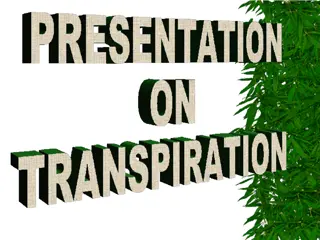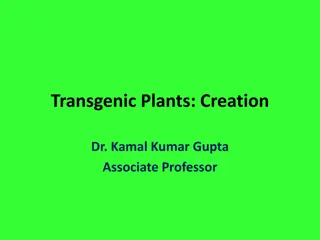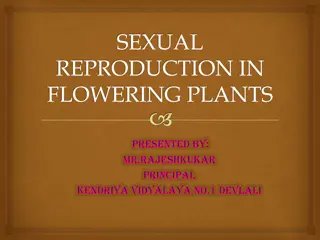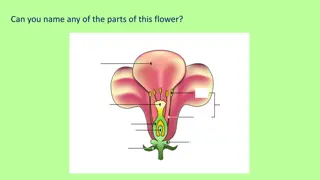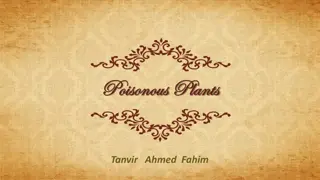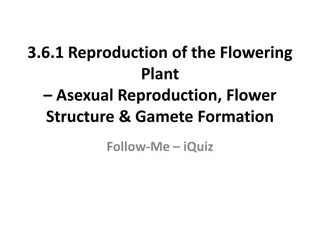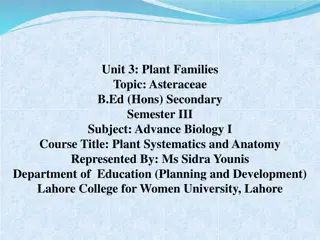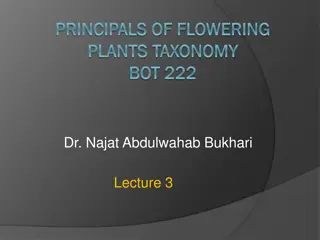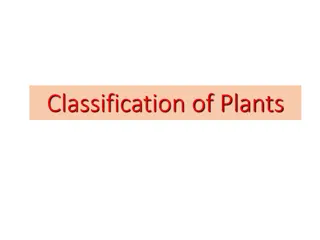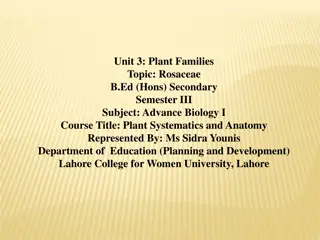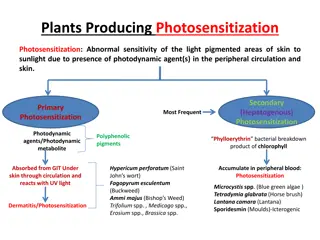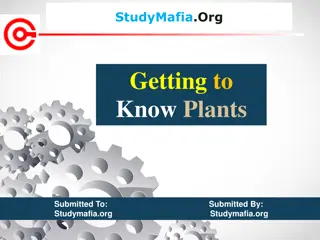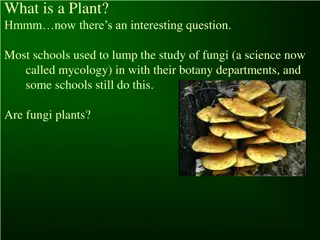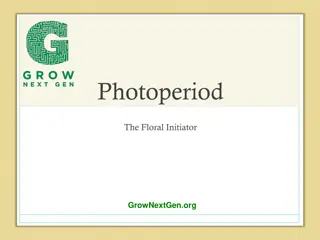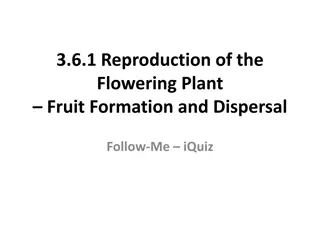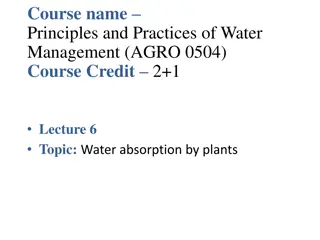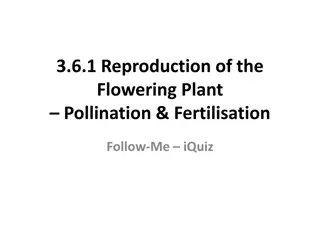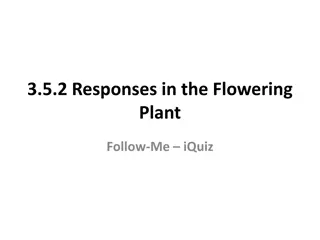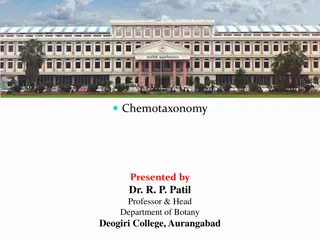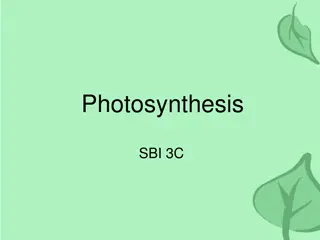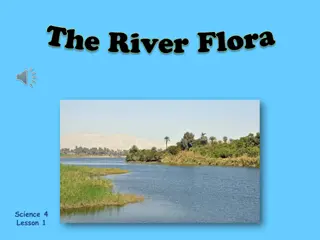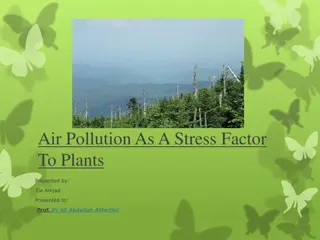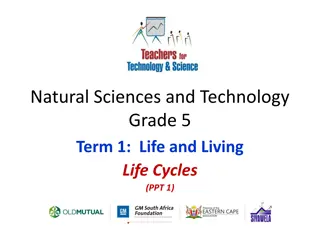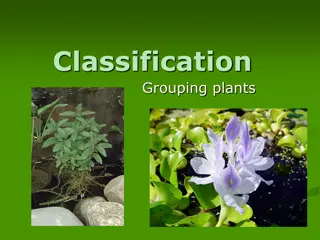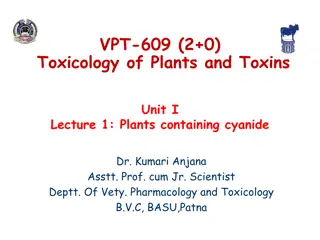Energy Production
Explore different aspects of energy production and efficiency in thermal power plants, water heaters, coal-fired electrical generation plants, and natural gas electrical generation plants. Learn about energy density, mass calculations, overall efficiencies, and specific energy requirements in these
7 views • 57 slides
Discovering the Benefits of Auto-Flowering Cannabis Strains
Auto-flowering cannabis strains have emerged as a game-changer in the world of cultivation, offering numerous benefits for growers of all levels. Unlike traditional photoperiod cannabis strains, which rely on changes in light cycles to trigger flowering, auto-flowering varieties transition into the
6 views • 4 slides
Understanding the Life Cycle of Flowering Plants
Explore the fascinating life cycle of flowering plants, from pollination to seed dispersal. Discover the stages, types of pollination, and various methods of seed dispersal through engaging visuals and resources. Enhance your knowledge and understanding of plant biology with interactive activities a
1 views • 7 slides
Understanding the Morphology of Flowering Plants: Root and Shoot Systems and Plant Parts
Flowering plants have a typical structure comprising root and shoot systems. The root system is homogenous and consists of roots and branches, while the shoot system is also homogenous and includes the stem, branches, leaves, and flowers. The plant body is divided into vegetative and reproductive pa
0 views • 115 slides
Understanding Flower Variations in Plants
Explore the diverse world of flowers in plants through examples and explanations of their reproductive parts and processes. Discover how some plants have both male and female flowers, while others have separate sex flowers. Learn about perfect flowers, the female and male parts of a flower, and the
0 views • 12 slides
Insights into Flowering and Floral Development in Plants
Plants regulate flowering through environmental signals perceived by the shoot apex, leading to radical changes in cell fate during floral evocation. Transition to reproductive phase involves floral meristem development, initiation of floral organs, and regulation by different gene types influencing
0 views • 39 slides
Understanding Plant Hormones and Their Functions in Plants
Plant hormones play crucial roles in various plant processes such as growth, development, and response to environmental stimuli. Auxins, gibberellins, and abscisic acid are key plant hormones that regulate tropisms, cell division, elongation, flowering, seed germination, and dormancy. Understanding
1 views • 50 slides
Understanding Seed Dispersal in Flowering Plants
Explore the fascinating world of seed dispersal in flowering plants, from wind dispersal to bursting pods and shaking mechanisms. Discover the various methods plants use to spread their seeds and ensure their survival. Dive into the stages of a flowering plant's life cycle and learn how germination,
1 views • 16 slides
Understanding Thermal Power Plants: Overview and Operation
Thermal power plants play a crucial role in converting heat energy into electricity for various applications. This article covers the definition, layout, working principle, and components of thermal power plants, highlighting their advantages and top features. From converting heat into mechanical po
0 views • 20 slides
Understanding Transpiration and Gas Exchange in Plants
Transpiration is the evaporation of water from plants, mainly occurring through the leaves' stomata. Plants exchange gases like CO2 and O2 through various parts, without specialized organs. The process aids in photosynthesis, respiration, and cooling, demonstrating the importance of transpiration in
0 views • 22 slides
Understanding Transgenic Plants and Agrobacterium Tumefaciens in Plant Biotechnology
Creation of transgenic plants involves various methods such as microprojectile DNA-coating, electroporation, and Agrobacterium transformation. Agrobacterium tumefaciens, a soil bacterium, plays a crucial role in inducing crown gall disease in plants by transferring T-DNA from the Ti plasmid. The Ti
1 views • 27 slides
Understanding Sexual Reproduction in Flowering Plants
Explore the fascinating process of sexual reproduction in flowering plants, presented by Mr. Rajeshkukar, Principal of Kendriya Vidyalaya No. 1 Devlali. Discover the parts of a flower, including the androecium and gynoecium, stamen, anther structure, and microsporogenesis. Dive into the intricate de
8 views • 35 slides
Explore the Fascinating Life Cycle of Flowering Plants
Discover the various parts of a flower such as petals, stigma, stamen, anther, filament, nectary, sepal, ovary, and ovule. Learn about the role each part plays in plant reproduction by exploring activities on flower anatomy, seed dispersal, pollination, germination, and growth. Engage with interacti
0 views • 7 slides
Understanding Poisonous Plants and Their Effects on Humans
Poisonous plants can have deleterious effects on individuals, leading to severe consequences and even death if not managed properly. These plants produce toxins that interfere with the body's essential functions, ultimately causing impairment and potential fatality. Recognizing the grades of poisoni
0 views • 11 slides
Understanding Food Sources: Plants and Animals Explained
Food is essential for nourishing our bodies, and it comes from either plants or animals. Plants provide fruits, vegetables, grains, and more, while animals offer products like meat, milk, and eggs. Different parts of plants, such as roots, stems, and leaves, are consumed as food. Animals have varied
0 views • 11 slides
Understanding Vegetative Propagation in Flowering Plants
This content explores the concept of vegetative propagation in flowering plants, focusing on asexual reproduction, flower structure, and gamete formation. It covers topics such as types of vegetative propagation, reproductive mechanisms, and the advantages of this process. Readers can test their kno
0 views • 50 slides
Asteraceae: The Composite Family of Flowering Plants
Asteraceae, commonly known as the Composite family, is a diverse group of plants with over 1,620 genera and 23,600 species worldwide. This family is recognized for its ornamental garden plants like Asters, Chrysanthemums, and Dahlias. With a unique characteristic of flower heads composed of small fl
0 views • 13 slides
Understanding Plant Taxonomy: A Comprehensive Overview of Flowering Plants
Plant taxonomy involves the study of various characteristics such as morphology, anatomy, photochemistry, cytology, and palynology. It plays a crucial role in the classification and understanding of plants. This content explores the principles of flowering plants, university vision and mission state
0 views • 30 slides
Understanding the Classification of Plants - Non-flowering and Flowering Varieties
Explore the diverse world of plants through their classification into non-flowering (mosses, ferns, gymnosperms) and flowering categories. From the simplest mosses to the tall gymnosperms, learn about their characteristics, reproductive methods, and habitat preferences.
0 views • 20 slides
Mineral Absorption in Plants: Mechanisms and Types
Plants absorb minerals from the soil as ions through the roots, with the process of mineral absorption being distinct from water absorption. Mineral absorption in plants can occur through passive or active methods, each involving different mechanisms and energy requirements. Passive absorption is a
0 views • 14 slides
Asexual Reproduction in Plants: Methods and Examples
Asexual reproduction in plants, also known as vegetative propagation, involves various methods such as tubers, bulbs, and runners. It allows plants to reproduce without the involvement of sex cells and fertilization, resulting in genetically identical offspring. Artificial propagation techniques lik
0 views • 11 slides
Exploring the Diverse World of Rosaceae Plant Family
Rosaceae, known as the rose family, is a significant family of flowering plants with a wide distribution, encompassing various herbs, shrubs, and trees. This family, with its 4,828 known species in 91 genera, plays a crucial role in ecosystems and economies worldwide. The Rosaceae family offers a va
0 views • 10 slides
Understanding Photosensitization in Plants: Causes and Toxicity
Photosensitization in plants can lead to abnormal skin sensitivity to sunlight, caused by the presence of photodynamic agents in the skin and peripheral circulation. Primary and secondary photosensitization are common, with various plants and toxins contributing to liver damage and biliary occlusion
0 views • 12 slides
Exploring the World of Plants: An Overview
Plants play a vital role in sustaining life on Earth by producing food and oxygen. This comprehensive guide delves into the diverse types of plants, such as herbs, shrubs, trees, creepers, and climbers. It also discusses the essential components of plants, like leaves, transpiration, and photosynthe
0 views • 20 slides
A Closer Look at Plants and Their Importance in Our Ecosystem
Plants play a vital role in our ecosystem, not only through photosynthesis but also in regulating atmospheric gases like oxygen and carbon dioxide. Understanding the definition of plants, from green algae to flowering plants, is essential. By studying plants, we uncover their critical contribution t
0 views • 12 slides
Understanding Photoperiodism in Plants
Photoperiodism is the ability of plants to detect day length, allowing them to know the season of the year and trigger specific physiological events. Earth's axis tilt and latitude influence day length variations, leading to distinct photoperiod responses in plants. This phenomenon plays a crucial r
0 views • 13 slides
Understanding Plant Classification and Characteristics
Discover the classification of plants based on their structures and characteristics, including vascular vs. nonvascular plants, seed plants vs. seedless plants, and the definitions of angiosperms, gymnosperms, dicots, and monocots. Learn about the history of plant classification and how plants are g
0 views • 27 slides
Reproduction of Flowering Plants: Seed Development and Endospermic Seeds
The quiz content discusses the process of seed development in flowering plants, focusing on the formation and dispersal of fruits. It touches upon the different parts of a seed, such as the seed leaf, food store, ovule, and endosperm, highlighting their roles in the growth of new plants. Additionall
0 views • 50 slides
Water Absorption by Plants: Mechanisms and Adaptation Strategies
Understanding water absorption by plants is crucial for effective water management in agriculture. Plants absorb water through active and passive methods, driven by osmotic and non-osmotic processes. Root hairs play a significant role in facilitating water uptake, with mechanisms such as osmotic act
0 views • 26 slides
Beware of Pests and Diseases on Plants - Protect Your Home Garden
Pests and diseases can easily hide on plants, seeds, fruits, vegetables, and flowers, posing a threat to your home garden. Bringing infected plants home can lead to widespread infestations and damage. It's crucial to be vigilant and avoid importing potentially contaminated greenery. Stay informed, i
0 views • 4 slides
Flowering Plant Reproduction: Pollination, Fertilisation, and more
Explore the process of pollination and fertilisation in flowering plants through an interactive quiz. Learn about the fusion of gametes, formation of endosperm and zygote, seed development, and more. Test your knowledge on plant reproduction and understand the intricate mechanisms involved.
1 views • 50 slides
Understanding Plant Growth Regulators in Flowering Plants
Explore the responses of flowering plants to growth regulators through an engaging quiz format. Learn about the secretion of growth regulators in different plant locations and examples of synthetic growth regulator usage. Test your knowledge on plant stimuli, harmful surroundings, geotropism, and mo
0 views • 50 slides
Understanding Chemotaxonomy: Classification of Plants Based on Chemical Constituents
Chemotaxonomy, presented by Dr. R. P. Patil, explores the scientific investigation of the chemical characters in plants for taxonomy and phylogeny studies. It involves classifying plants based on their chemical constituents and molecular characteristics. Principles, methods, and importance of chemot
0 views • 24 slides
Understanding Photosynthesis: The Process of Energy Conversion in Plants
Photosynthesis is a vital process where plants, algae, and cyanobacteria convert light energy from the sun into chemical energy in the form of glucose. This energy conversion involves the absorption of light by chlorophyll molecules in chloroplasts, leading to the generation of ATP and the formation
0 views • 12 slides
Diversity of Plants in Rivers and Streams
In rivers and streams, a variety of plants play essential roles by providing shelter, food, and oxygen to animals. From white poplar to water lilies, different plants thrive along riverbanks and in water bodies, contributing to the ecosystem's health and balance. Aquatic plants like water lettuce an
0 views • 6 slides
Understanding Air Pollution Stress on Plants
The impact of air pollution on plants is a significant concern, affecting their physiology and overall health. Various air pollutants, such as sulfur dioxide, ozone, and nitrogen compounds, have been identified as phytotoxic agents, leading to severe or subtle effects on plant life. Detecting the ef
0 views • 21 slides
Understanding Life Cycles: Plants and Animals
Explore the fascinating world of life cycles in plants and animals through engaging visuals and descriptions. From the process of germination to the different stages of growth and development, discover how living organisms move through their life cycles. Topics include plant pollination, seed disper
0 views • 14 slides
Plant Classification and Reproduction Overview
Plants are categorized into four groups: Mosses, Ferns, Conifers, and Flowering Plants. Mosses reproduce by spores and lack roots or xylem vessels. Ferns reproduce via spores, while conifers reproduce with seeds found in cones and have needle-shaped leaves. Flowering plants reproduce using seeds fou
0 views • 8 slides
Understanding Cyanogenic Plants and Cyanide Poisoning in Animals
This lecture introduces the toxicology of plants containing cyanide, focusing on factors affecting cyanide poisoning, cyanogenic plants, mechanisms of toxicosis, clinical signs, post-mortem lesions, diagnosis, treatment, and prevention. It discusses species variations in susceptibility, plant growth
0 views • 22 slides
Understanding Monocot Plants: Features and Families
Monocotyledon plants, a significant group of flowering plants, have unique characteristics such as adventitious roots, parallel-veined leaves, and flowers with parts in sets of three or four. The Poaceae family, including economically important grasses, and the Cyperaceae family, known as sedges, ar
0 views • 7 slides

